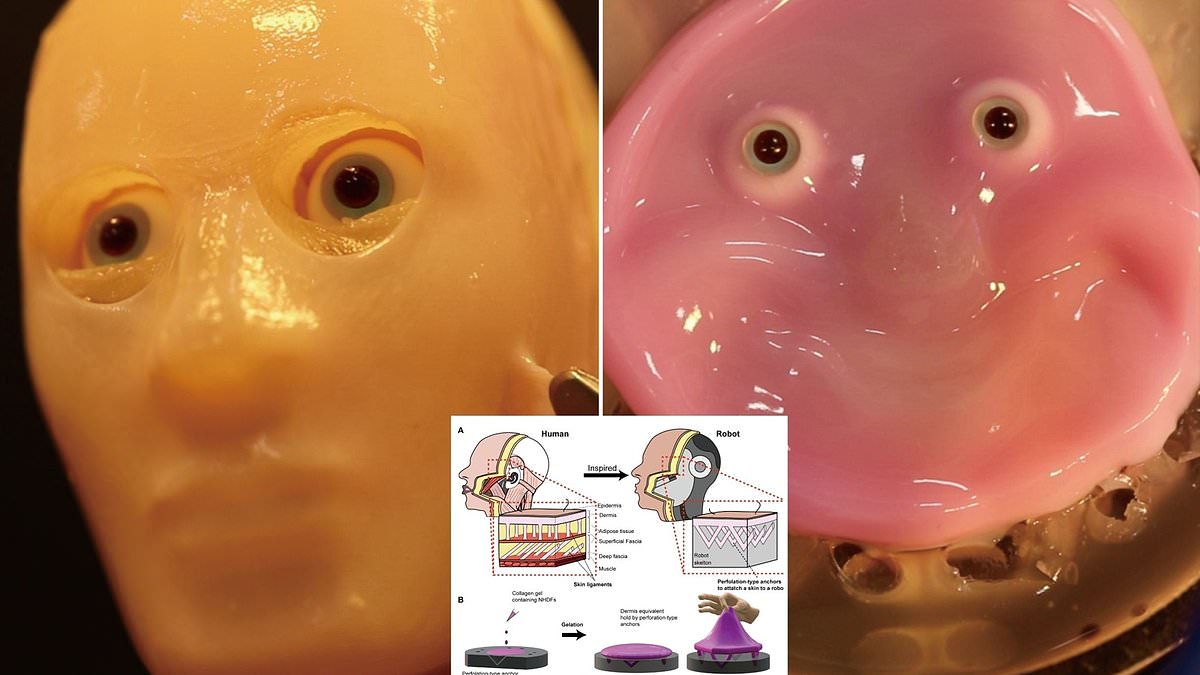- The robot face is covered with skin grown from a cell sample in the laboratory
- READ MORE: Watch a creepy humanoid robot mimic facial expressions
In science fiction films like Alien, humanoid robots are so lifelike that it is almost impossible to distinguish them from a real person.
Now scientists in Japan are on their way to creating lifelike versions of these realistic machines.
The experts at the University of Tokyo have created a robot face from human skin grown in a laboratory.
Creepy video shows the bizarre pink creation trying on a goofy smile.
According to the scientists, robots with real skin not only “look increasingly lifelike” but can heal themselves if damaged.
Click here to change the format of this module
The research was led by Professor Shoji Takeuchi of the University of Tokyo and detailed in a new study in Cell Reports Physical Science.
Professor Takeuchi’s lab has already created mini robots that can walk using biological muscle tissue, 3D-printed lab-grown meat and modified skin that can heal.
“We have managed to imitate the human appearance to a certain extent by creating a face with the same surface material and structure as humans,” says Professor Takeuchi.
The ‘engineered skin tissue’ is made by taking a sample of human skin cells and growing them in the laboratory – similar to the way cultured meat is developed.
Co-author of the study, Michio Kawai from Harvard University, told MailOnline: ‘These human skin cells are mainly harvested from excess skin obtained during surgery.
‘Cultured skin has the same composition as human skin and is also used as a graft material for people with severe burns or injuries.’
Click here to change the format of this module
While developing living skin from cell cultures has its own challenges, the most difficult part was getting the skin to adhere to a robot face made of acrylic-based resin.
Previous methods involved mini anchors or hooks, but these limited the types of surfaces to which skin coatings could be applied and which could cause damage during movement.
Instead, the team used a special collagen gel for bonding and made special perforations in their robot’s face, allowing the layer of lab-grown skin to stay in place.
By carefully making small perforations, skin can be inserted into almost any kind of surface, they say.
Although there is still a long way to go before talking humanoids look exactly like us, Professor Takeuchi and colleagues believe that living skin could provide robots with a range of new skills.
Robots with skin on their faces have self-healing capabilities, embedded sensing capabilities and an “increasingly lifelike appearance.”
“This study introduces an approach to bond and activate skin equivalents with perforation-type anchors, potentially contributing to advances in biohybrid robotics,” they say in their paper.
‘Unlike other self-healing materials, which require heat or pressure to cause adhesion to cut surfaces, skin equivalent can regenerate defects through cellular proliferation without any trigger.’
The next challenge will be to create a series of human-like expressions by integrating advanced actuators, similar to muscles, into the robot.
